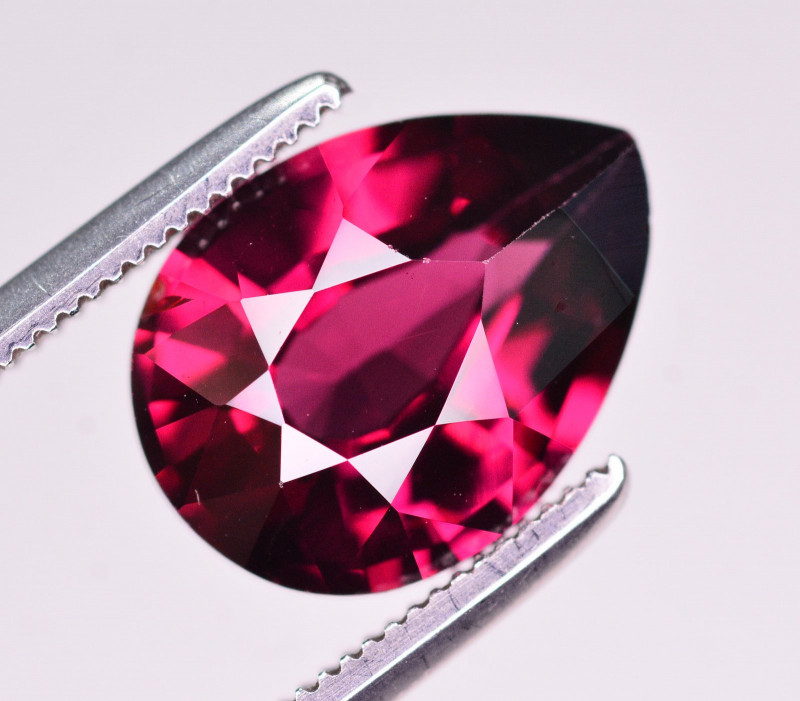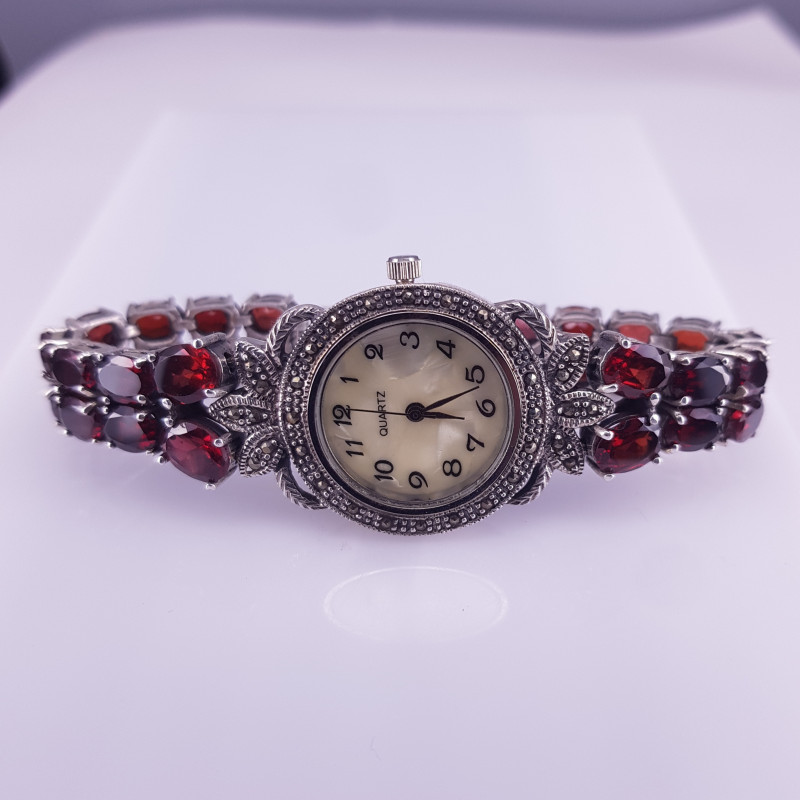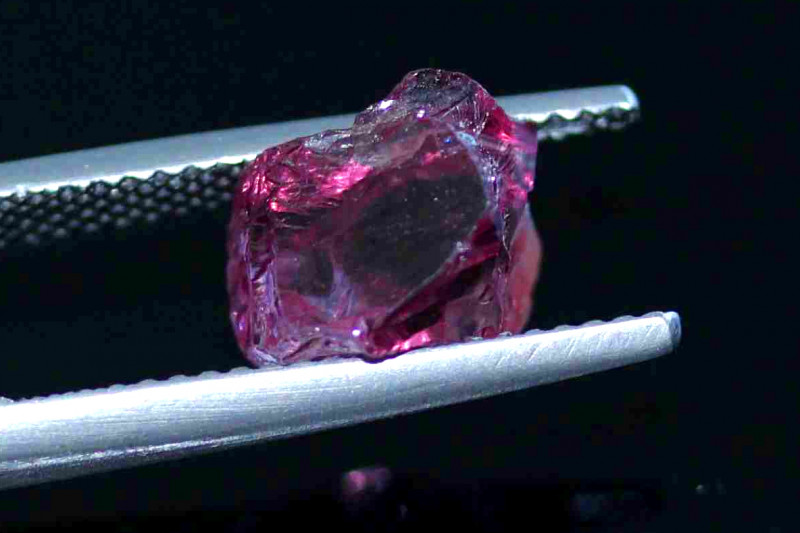Pyrope Garnet: Meaning, Prices & Properties Info Guide
 Pyrope is the most well-known red garnet variety, though its shade varies. Is pyrope a gemstone? Absolutely! It’s most popular in faceted, blood-red or pomegranate-hued gems. It’s the only garnet to consistently show red coloring.
Pyrope is the most well-known red garnet variety, though its shade varies. Is pyrope a gemstone? Absolutely! It’s most popular in faceted, blood-red or pomegranate-hued gems. It’s the only garnet to consistently show red coloring.
Is pyrope garnet rare? Not exactly. Though it’s less abundant than other garnets, it’s among the most popular for jewelry.
If you’re ready to learn the ropes on pyrope, join us as we break down all of pyrope’s meanings, prices, history, and more!

About Pyrope Stone
Pyrope garnet is a semi-precious gemstone with many monikers. Some popular ones are “Bohemian garnet” or “Cape ruby.” However, pyrope is not a ruby, so selling pyrope under any of these names is forbidden by the Federal Trade Commission (FTC).
For the new year babies, pyrope garnet is your January birthstone! It’s also a zodiac stone for Aries, Capricorn, and Aquarius. Garnet is also the traditional gift for commemorating the second wedding anniversary!
Pyrope Specifications & Characteristics
The garnet family has two overarching species: ugrandite and pyralspite. Pyrope falls under the pyralspite series with spessartite and almandine.
Pyrope is a magnesium aluminum silicate. Common impurities in pyrope are calcium, iron, manganese, and chromium.
The pure pyrope formula is Mg3Al2Si3O12 or Mg3Al2(SiO4)3, but natural pyrope is never pure. The highest pyrope content found in gem-quality stones reached 83 percent.
Almandine and pyrope can be difficult to distinguish. Chemically, pyrope contains more magnesium while almandine contains more iron. The best test to distinguish the two is density — almandine’s typical 4.3 density is higher than pyrope’s typical 3.6 density.
The remaining pyrope mineral data is listed below:
Mohs hardness: 7-7.5
Color: Red, pink, brownish-red, purple-red, orange-red, blackish-red, purple
Crystal structure: Isometric/Cubic
Luster: Vitreous (glassy) or greasy
Transparency: Transparent to opaque
Refractive index: 1.73-1.76
Density: 3.65-3.87
Cleavage: None
Fracture: Conchoidal
Streak: White
Luminescence: None
Optical effects: Rarely color-changing

Types of Pyrope
Pyrope has one official variety, chrome pyrope. However, pyrope commonly mixes with other garnet species to form new varieties.
Chrome Pyrope

Chrome pyrope is a chromium-rich variety, which imparts a deeper red. It can also be violet-red. Those with a chromium oxide content between 3-8 percent are violet to royal purple with green undertones.
These are most well-known from Arizona, USA, where they’re found discarded by ants around anthills.
So, is pyrope garnet the same as anthill garnet? Sort of. Anthill garnets, pulled out by ants, are intense, bright red chromium pyropes in small sizes (the ants can only haul so much).
Pastel Pyrope

First introduced by gemologist Carol Stockton in 1988, though not officially recognized, pastel pyrope is a paler pink, maroon, orange-red, or purple variety.
They’re 74-88 percent pyrope with low iron and manganese but high magnesium. However, their refractive index is lower than other pyropes.
Mozambique Garnets

Mozambique garnets are pyrope and almandine mixtures discovered in Mozambique, Africa. These garnets display red hues with orange and brown undertones.
Rhodolite is also a pyrope-almandine mixture. However, Mozambique garnets are redder, darker, and generally have more almandine than pyrope.
Rhodolite

Rhodolite is an almost even mixture of pyrope and almandine. Traditionally, gems called “rhodolite” are purplish-red, but they can range from light rose-red to violet or purple shades.
Sometimes, rhodolite also has spessartite mixed in. These are generally paler in hue. If iron and magnesium impurities are present, rhodolite becomes deep purple, sometimes called “grape garnets.”
Additionally, Tanzanian rhodolites composed of all three pyralspites have bright magenta-rose coloring with flashes of pale pink and are dubbed “Umbalite garnets.”
Color-Change Garnet (Malaya Garnet & More)


Though almost all garnet species can have color-changing varieties, the most common are pyrope-spessartite mixtures.
One of the rare but popular types is Malaya (or Malaia) garnet, the pyrope-spessartite or pyralspite variety. Malaya garnets are usually pink to orange, but color-changing varieties may appear pink, salmon, or magenta in daylight and reddish-pink, light purple, pink, or pink-orange in incandescence.
The most notable color-changing pyrope is the predominantly pyrope-spessartite, blue-green to purple shifting type discovered in the 1990s. These have sold for up to $4.8 million!
Other color-changing pyropes come from:
Idaho: Pyrope-almandine, red to purple-red
East Africa: Pastel pyrope, pink to purple
Norway: Pyrope-almandine, violet-red to blue-green or violet to wine-red
Tanzania: Pyrope-spessartite, greenish-blue to magenta or pinkish-purple to bright pink to purple
Onto pyrope’s symbolism and history!

Pyrope Meaning & History
Pyrope carries traditional garnet lore. Associated with pomegranates (part of the “garnet” name’s inspiration), pyrope has similarly represented love and blood.
In ancient times, red garnets were believed to protect travelers, lighting their way. During the Middle Ages, the stones were used for treating nightmares, hemorrhages, and depression.
Ancient Greeks believed garnets were poison antidotes and prevented children drowning. In the US, Native Americans used anthill garnets to create rattles for rituals or gifts of gratitude.
Some religious lore tied to pyrope includes:
Symbolizes Jesus Christ’s blood sacrifice in Christianity
Lights up the fourth level of heaven in Islam
Used in a lantern by Noah to navigate his ark through floods in Judaism
Let’s move from the legends and into pyrope’s past!
Ancient History
The name “pyrope” comes from the Greek pyrōpos, for “fiery-eyed.” (Pyr means “fire” and ōps means “eye.”) This reflects the stone’s high refractive index, color, and sparkle.
The first to use “pyropus” was Latin geographer and linguist Gaius Julius Solinus around 300 AD.
Archeological evidence dates garnet gemstones back to 3100-BC Egyptian jewelry. Ancient Romans often donned signet pyrope garnet rings, and Egyptian pharaohs were buried wearing their garnet necklaces.
Famous 4th-century BC philosopher Plato allegedly requested his portrait be carved onto garnet. According to Roman naturalist Pliny the Elder, red garnets were among the most popular gems in 1st-century AD.
An earlier name for red garnet was “carbuncle,” particularly for cabochons.

Middle Ages to Victorian Era
In Medieval times (1st century to 15th century AD), clergy joined royals in wearing garnets. Most significantly, an abundant pyrope deposit in Bohemia (present-day Czechia) was discovered during the 1500s.
Dubbed “Bohemian garnet” or “Bohemian ruby,” these pyropes became the predominant jewelry gem. In the 1600s, they also gained the moniker “Prague garnets.”
Throughout the 1800s, these “Prague” or “Bohemian” garnets were the best around. Mining them was a huge Czechian industry.
Beliefs about garnet’s power were still prevalent, too. During the Hunza-Nagar Campaign of 1891 in Pakistan, the Hunza used garnet bullets, believing them deadlier.
Pyrope was most popular during the Victorian Era (1837 to 1901). Industrialization made pyrope jewelry more accessible and abundant than ever... but indirectly led to pyrope’s decline.
Modern History
Victorian-era jewelry decreased in popularity in the early 1900s. Plus, paler-hued pyrope discovered around this time in the USA, India, and South Africa became more popular.
South African pyropes in particular were larger and more attractive than traditional “Bohemian” garnets. Their source and beauty earned them the moniker “Cape ruby.”
With wider availability, pyropes became less valuable and lost their distinguished status.
Their status would eventually be replaced by the color-changing pyropes, with blue coloring once considered impossible in garnets, discovered in Madagascar in the 1990s.

Pyrope Healing Properties
Every pyrope variety is a unique healing stone. As a red gemstone, pyrope’s healing benefits inherently include vitality, passion, and strength. Varieties with more violet hues possess the purple gemstone benefits of raising intuition and spiritual awareness.
Being red, pyrope crystals serve as chakra stones for opening the root chakra to restore feelings of balance and connection.
What about the physical and emotional pyrope garnet benefits?
Physical Healing
Physically, pyrope is said to help with:
Arthritis
Sore throat
Inflamed or burned skin
Digestive issues
Immune system function
Pyrope’s blood associations mean it’s also believed to stop excessive bleeding, promote blood circulation, and treat blood disorders.
Emotional Healing
Emotionally, pyrope can help those feeling anxious, insecure, or despondent. These crystals are said to give you a boost of energy, composure, and motivation, especially at work. Pyrope also purportedly increases bravery and lightens up emotionally heavy situations.

Pyrope Gemstone Properties
Pyrope garnet’s value is determined by standard properties: color, cut, clarity, carat weight, and synthetics/simulants.
Color
The best pyrope color depends on your preference:
Deep red: Malaya, chrome pyrope, Mozambique, or rhodolite
Pink: Rhodolite (raspberry), Malaya, or pastel pyrope
Purple: Rhodolite (“grape garnet” type), chrome pyrope, Mozambique (new finds), or pastel pyrope
The cause of pyrope’s color varies. Deep brownish to black stones often contain andradite and ilmenite inclusions. Bright pink or purple hues come from traces of manganese and iron.
Purple is the most valuable rhodolite color, but color-changing pyropes are most valuable overall. The best color-change garnets show a strong, distinct change.
Cut
Pyrope lends well to all faceted cuts. It has moderate dispersion (colorful sparkle), so brilliant cuts display this fire best.
Malaya garnets also contain vanadium or chromium impurities, allowing them to sparkle with red flashes if faceted.
Pyrope garnets may also be cut as cabochons.

Clarity
Many pyropes have a Type II colored gemstone clarity grade, so some visible inclusions are common. Inclusions include needles, quartz snowball crystals, or enstatite.
However, Malaya garnets and many cut pyropes are inclusion-free, so you shouldn’t settle for visibly included gems.
Carat Weight
Large, cut pyropes are very rare. Most faceted pyropes are only 1-2 carats. Smaller stones have better coloring, though, as larger sizes are darker. Only one faceted Bohemian garnet exceeded 5 carats.
Some varieties have higher price rates based on size, while others don’t. Mozambique garnets and plain red pyropes don’t change rates.
Color-changing pyrope’s rates increase for both size and source. Rhodolite is the only variety sold in sizes beyond 10 carats, but 10-carat or higher rhodolites are the most expensive of all pyropes.
Synthetics & Simulants
You may see some synthetic pyropes, but simulants are more likely. Common simulants are other (cheaper) red gems, dyed cubic zirconia, or red glass.

Pyrope Formation & Sources
Garnets like pyrope usually form inside aluminum-rich sedimentary rocks undergoing metamorphism. The process often happens at convergent tectonic plates and involves heat and pressure changing the composition of minerals inside, creating new minerals like garnet.
Because garnets are so tough, they’re one of the only minerals left behind after intense weathering. They’re usually found in kimberlites, serpentine rocks, mineral sand dunes, and peridotites. In kimberlites, chrome pyropes indicate the possible presence of diamonds.
Mining Locations
Where is pyrope found? All over! Although, some locales are more important than others. We’ll list each type of pyrope with its primary sources:
Color-Changing: Afghanistan, East Africa, Idaho (USA), Norway, Madagascar, Sri Lanka, Tanzania
Red pyrope: China, Czechia, South Africa, Madagascar
Malaya: Kenya, Madagascar, Tanzania
Rhodolite: Brazil, India, North Carolina (USA), Sri Lanka, Tanzania, Thailand
Chrome Pyrope: Arizona & New Mexico (USA), Tanzania
Mozambique: Mozambique (of course)
Now, how much is pyrope garnet worth?

Pyrope Price & Value
The pyrope garnet price per carat differs significantly based on variety and quality. We’ll start with faceted options that don’t change in price-per-carat based on size:
Mozambique: $5-$35 per carat
Red Pyrope: $20 per carat
Chrome Pyrope: $50-$100 per carat
Next, here are the prices of faceted varieties weighing 0.5-1 carats with good quality:
Rhodolite: $20-$100 per carat
American Color-Changing: $25-$40 per carat
Malaya: $30-$60 per carat
African Color-Changing: $80-$2,500 per carat
Now for the prices of faceted varieties weighing over 1 carat with good quality:
Rhodolite: $20-$150 per carat (1-10 cts); $150-$300 per carat (10+ cts)
American Color-Changing: $35-$80 per carat (1-6 cts)
Malaya: $150-$200 per carat (1-5 cts); $300-$3,000 per carat (5+ cts)
African Color-Changing: $120-$6,000 per carat (1-6 cts)
Cabochons are much more affordable.
Rhodolite cabochons are $4-$6 per carat under 1 ct, $5-$30 per carat when 1-10 cts, and up to $40 per carat when over 10 cts. Mozambique garnet cabochons are only $5-$7 per carat.
At wholesale, red pyrope garnet jewelry is generally around $30-$35.
Pyrope Care and Maintenance
Luckily, pyrope is hard, durable, and cleavage-free, making pyrope garnet jewelry great for regular wear. Still, proper gemstone care is important to prevent fractures or scratches.
The standard cleaning method of using warm water, mild soap, and a soft toothbrush is the best for cleaning pyrope garnets. Avoid ultrasound cleaners or extreme heat, as this can cause inclusions to turn into fractures. Also, keep pyrope away from strong acids.

Restore Passion & Hope with Pyrope!
Now that you’ve learned the ropes about pyrope, you can see why this ancient gem remained so mystical for centuries. These red crystals can infuse your daily life with energy, hope, and passion, reminding you not to take yourself too seriously.
As Dutch philosopher Desiderius Erasmus said, “The highest form of bliss is living with a certain degree of folly.”
Not sure which variety is your favorite? Browse all kinds of pyrope gemstones today!
Was this article helpful?
Ross Sedawie
- Written - 24th Jul 2022
- Edited - 20th Nov 2023




















